Evidence! Citation & Analysis for the Family Historian
Suggested Citation:"Evidence Supporting Biological Evolution." National Academy of Sciences. 1999. Science and Creationism: A View from the National Academy of Sciences, 2nd Edition. Washington, DC: The National Academies Press. doi: 10.17226/6024.
×
Evidence Supporting Biological Evolution
Forth path leads from the origins of archaic "life," which existed at to the lowest degree 3.5 billion years ago, to the profusion and diverseness of life that exists today. This path is best understood as a product of evolution.
Contrary to popular opinion, neither the term nor the idea of biological evolution began with Charles Darwin and his foremost piece of work, On the Origin of Species past Means of Natural Selection (1859). Many scholars from the ancient Greek philosophers on had inferred that similar species were descended from a mutual antecedent. The word "evolution" first appeared in the English language in 1647 in a nonbiological connection, and information technology became widely used in English for all sorts of progressions from simpler beginnings. The term Darwin most often used to refer to biological evolution was "descent with modification," which remains a expert brief definition of the process today.
Darwin proposed that evolution could exist explained by the differential survival of organisms following their naturally occurring variation—a process he termed "natural selection." According to this view, the offspring of organisms differ from one another and from their parents in means that are heritable—that is, they can pass on the differences genetically to their own offspring. Furthermore, organisms in nature typically produce more than offspring than can survive and reproduce given the constraints of food, infinite, and other environmental resources. If a item off-
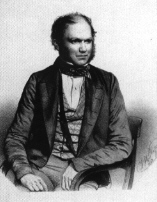
Charles Darwin arrived at many of his insights into evolution by studying the variations among species on the Galápagos Islands off the coast of Ecuador.

Suggested Citation:"Show Supporting Biological Evolution." National Academy of Sciences. 1999. Scientific discipline and Creationism: A View from the National Academy of Sciences, Second Edition. Washington, DC: The National Academies Press. doi: x.17226/6024.
×
spring has traits that requite it an advantage in a particular environment, that organism will be more likely to survive and pass on those traits. Equally differences accumulate over generations, populations of organisms diverge from their ancestors.
Darwin'due south original hypothesis has undergone extensive modification and expansion, but the central concepts stand up firm. Studies in genetics and molecular biology—fields unknown in Darwin'southward time—have explained the occurrence of the hereditary variations that are essential to natural selection. Genetic variations event from changes, or mutations, in the nucleotide sequence of Dna, the molecule that genes are made from. Such changes in DNA now can be detected and described with nifty precision.
Genetic mutations arise by chance. They may or may not equip the organism with better means for surviving in its environment. But if a factor variant improves adaptation to the environment (for case, by assuasive an organism to make better utilise of an bachelor food, or to escape predators more finer—such as through stronger legs or disguising coloration), the organisms conveying that gene are more than likely to survive and reproduce than those without it. Over time, their descendants will tend to increase, changing the average characteristics of the population. Although the genetic variation on which natural choice works is based on random or chance elements, natural selection itself produces "adaptive" change—the very opposite of chance.
Scientists besides accept gained an understanding of the processes by which new species originate. A new species is one in which the individuals cannot mate and produce viable descendants with individuals of a preexisting species. The split of one species into two often starts because a group of individuals becomes geographically separated from the residue. This is peculiarly credible in distant remote islands, such as the Galápagos and the Hawaiian archipelago, whose bully distance from the Americas and Asia means that arriving colonizers will have little or no opportunity to mate with individuals remaining on those continents. Mountains, rivers, lakes, and other natural barriers also account for geographic separation betwixt populations that in one case belonged to the same species.
Once isolated, geographically separated groups of individuals go genetically differentiated every bit a consequence of mutation and other processes, including natural choice. The origin of a species is ofttimes a gradual process, so that at kickoff the reproductive isolation between separated groups of organisms is only partial, but it eventually becomes complete. Scientists pay special attention to these intermediate situations, because they help to reconstruct the details of the process and to identify particular genes or sets of genes that account for the reproductive isolation between species.
A especially compelling example of speciation involves the 13 species of finches studied by Darwin on the Galápagos Islands, now known as Darwin'southward finches. The ancestors of these finches appear to take immigrated from the Southward American mainland to the Galápagos. Today the different species of finches on the island have singled-out habitats, diets, and behaviors, but the mechanisms involved in speciation continue to operate. A inquiry group led by Peter and Rosemary Grant of Princeton University has shown that a unmarried yr of drought on the islands tin can bulldoze evolutionary changes in the finches. Drought diminishes supplies of easily
Suggested Citation:"Evidence Supporting Biological Evolution." National Academy of Sciences. 1999. Science and Creationism: A View from the National Academy of Sciences, 2nd Edition. Washington, DC: The National Academies Press. doi: 10.17226/6024.
×
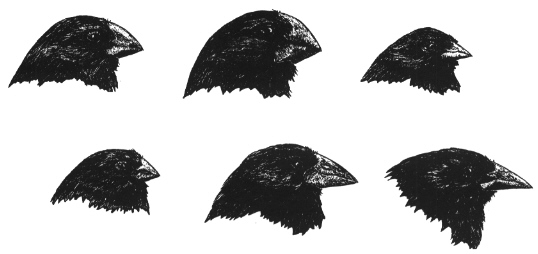
The different species of finches on the Galápagos Islands, now known as Darwin's finches, have dissimilar-sized beaks that take evolved to accept advantage of singled-out food sources.
cracked nuts merely permits the survival of plants that produce larger, tougher nuts. Droughts thus favor birds with strong, broad beaks that can suspension these tougher seeds, producing populations of birds with these traits. The Grants take estimated that if droughts occur most one time every ten years on the islands, a new species of finch might ascend in only nigh 200 years.
The following sections consider several aspects of biological evolution in greater detail, looking at paleontology, comparative anatomy, biogeography, embryology, and molecular biology for further evidence supporting development.
The Fossil Record
Although it was Darwin, above all others, who first marshaled convincing evidence for biological development, earlier scholars had recognized that organisms on World had changed systematically over long periods of time. For instance, in 1799 an engineer named William Smith reported that, in undisrupted layers of rock, fossils occurred in a definite sequential order, with more mod-actualization ones closer to the peak. Because lesser layers of stone logically were laid down earlier and thus are older than top layers, the sequence of fossils also could be given a chronology from oldest to youngest. His findings were confirmed and extended in the 1830s by the paleontologist William Lonsdale, who recognized that fossil remains of organisms from lower strata were more primitive than the ones to a higher place. Today, many thousands of ancient rock deposits take been identified that show corresponding successions of fossil organisms.
Thus, the general sequence of fossils had already been recognized before Darwin conceived of descent with modification. But the paleontologists and geologists earlier Darwin used the sequence of fossils in rocks not as proof of biological evolution, but as a footing for working out the original sequence of rock strata that had been structurally disturbed by earthquakes and other forces.
In Darwin's time, paleontology was still a rudimentary science. Large parts of the geological succession of stratified rocks were unknown or inadequately studied.
Suggested Citation:"Evidence Supporting Biological Evolution." National University of Sciences. 1999. Science and Creationism: A View from the National Academy of Sciences, Second Edition. Washington, DC: The National Academies Press. doi: x.17226/6024.
×
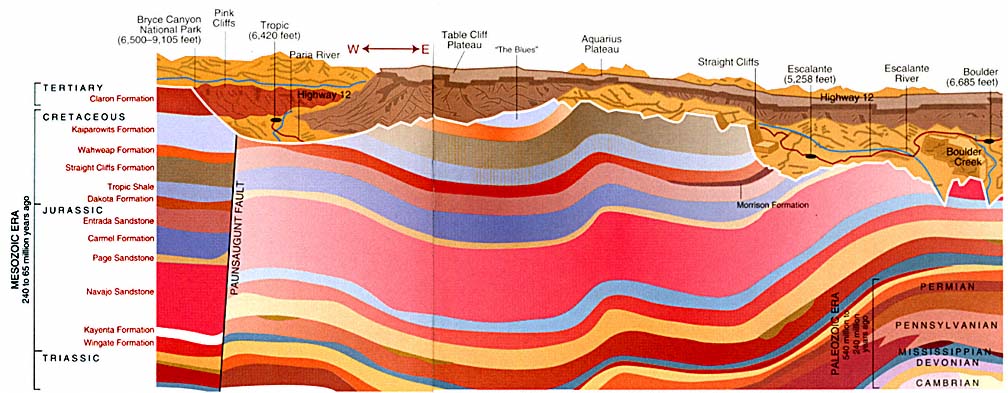
A geological cross department of the Grand Staircase-Escalante National Monument in Utah shows layers of sedimentary rock. These layers reveal deposits laid down over millions of years. Older fossils are found in the lower layers, revealing the succession of organisms over time

Weathering has exposed layers of sedimentary stone near the Paria River in Utah
Suggested Citation:"Prove Supporting Biological Evolution." National University of Sciences. 1999. Scientific discipline and Creationism: A View from the National University of Sciences, 2d Edition. Washington, DC: The National Academies Press. doi: 10.17226/6024.
×
Darwin, therefore, worried nearly the rarity of intermediate forms between some major groups of organisms.
Today, many of the gaps in the paleontological record have been filled by the inquiry of paleontologists. Hundreds of thousands of fossil organisms, found in well-dated rock sequences, correspond successions of forms through fourth dimension and manifest many evolutionary transitions. As mentioned earlier, microbial life of the simplest type was already in beingness iii.5 billion years ago. The oldest bear witness of more circuitous organisms (that is, eucaryotic cells, which are more complex than leaner) has been discovered in fossils sealed in rocks approximately 2 billion years old. Multicellular organisms, which are the familiar fungi, plants, and animals, have been found but in younger geological strata. The following list presents the order in which increasingly complex forms of life appeared:
| Life Class | Millions of Years Since Kickoff Known Appearance (Judge) |
| Microbial (procaryotic cells) | three,500 |
| Complex (eucaryotic cells) | 2,000 |
| Showtime multicellular animals | 670 |
| Crush-bearing animals | 540 |
| Vertebrates (simple fishes) | 490 |
| Amphibians | 350 |
| Reptiles | 310 |
| Mammals | 200 |
| Nonhuman primates | 60 |
| Earliest apes | 25 |
| Australopithecine ancestors of humans | v |
| Modern humans | 0.fifteen (150,000 years) |
Suggested Commendation:"Testify Supporting Biological Evolution." National Academy of Sciences. 1999. Science and Creationism: A View from the National Academy of Sciences, Second Edition. Washington, DC: The National Academies Press. doi: 10.17226/6024.
×
So many intermediate forms have been discovered between fish and amphibians, between amphibians and reptiles, betwixt reptiles and mammals, and along the primate lines of descent that it often is difficult to identify categorically when the transition occurs from one to some other item species. Actually, nearly all fossils can be regarded as intermediates in some sense; they are life forms that come between the forms that preceded them and those that followed.
The fossil record thus provides consequent evidence of systematic change through time—of descent with modification. From this huge body of evidence, it tin be predicted that no reversals will be found in hereafter paleontological studies. That is, amphibians will non appear earlier fishes, nor mammals earlier reptiles, and no complex life will occur in the geological record before the oldest eucaryotic cells. This prediction has been upheld by the evidence that has accumulated until now: no reversals take been establish.
Common Structures
Inferences about common descent derived from paleontology are reinforced by comparative anatomy. For example, the skeletons of humans, mice, and bats are strikingly like, despite the different ways of life of these animals and the diversity of environments in which they flourish. The correspondence of these animals, bone by os, can be observed in every part of the body, including the limbs; yet a person writes, a mouse runs, and a bat flies with structures built of bones that are unlike in item but similar in full general structure and relation to each other.
Scientists telephone call such structures homologies and have concluded that they are best explained past common descent. Comparative anatomists investigate such homologies, non only in bone structure simply too in other parts of the trunk, working out relationships from degrees of similarity. Their conclusions provide of import inferences about the details of evolutionary history, inferences that can exist tested by comparisons with the sequence of ancestral forms in the paleontological record.

A bat wing, a mouse forelimb, and a human arm serve very different purposes, just they take the aforementioned basic components The similarities ascend because all three species share a common 4-limbed vertebrate antecedent
Suggested Citation:"Prove Supporting Biological Evolution." National University of Sciences. 1999. Science and Creationism: A View from the National University of Sciences, 2nd Edition. Washington, DC: The National Academies Press. doi: 10.17226/6024.
×
The mammalian ear and jaw are instances in which paleontology and comparative anatomy combine to show common ancestry through transitional stages. The lower jaws of mammals contain only ane bone, whereas those of reptiles take several. The other bones in the reptile jaw are homologous with bones now plant in the mammalian ear. Paleontologists have discovered intermediate forms of mammal-like reptiles (Therapsida) with a double jaw joint—ane composed of the bones that persist in mammalian jaws, the other consisting of bones that eventually became the hammer and anvil of the mammalian ear.
The Distribution of Species
Biogeography as well has contributed bear witness for descent from common ancestors. The variety of life is stupendous. Approximately 250,000 species of living plants, 100,000 species of fungi, and one million species of animals take been described and named, each occupying its own peculiar ecological setting or niche; and the census is far from complete. Some species, such every bit human being beings and our companion the canis familiaris, tin live under a wide range of environments. Others are amazingly specialized. One species of a fungus (Laboulbenia) grows exclusively on the rear portion of the covering wings of a single species of beetle (Aphaenops cronei) found but in some caves of southern France. The larvae of the fly Drosophila carcinophila can develop only in specialized grooves beneath the flaps of the third pair of oral appendages of a land crab that is found only on certain Caribbean islands.
How can nosotros brand intelligible the colossal diversity of living beings and the existence of such extraordinary, seemingly whimsical creatures as the fungus, beetle, and fly described to a higher place? And why are island groups like the Galápagos and so often inhabited by forms like to those on the nearest mainland but belonging to different species? Evolutionary theory explains that biological diversity results from the descendants of local or migrant predecessors becoming adapted to their diverse environments. This explanation can be tested past examining present species and local fossils to come across whether they accept similar structures, which would point how one is derived from the other. Also, there should be bear witness that species without an established local ancestry had migrated into the locality.
Wherever such tests have been carried out, these atmospheric condition take been confirmed. A skilful case is provided by the mammalian populations of North and South America, where strikingly unlike native organisms evolved in isolation until the emergence of the isthmus of Panama approximately 3 million years ago. Thereafter, the armadillo, porcupine, and opossum—mammals of Due south American origin—migrated north, along with many other species of plants and animals, while the mount lion and other Due north American species made their mode across the isthmus to the south.
The show that Darwin found for the influence of geographical distribution on the evolution of organisms has go stronger with advancing knowledge. For example, approximately 2,000 species of flies belonging to the genus Drosophila are at present found throughout the earth. About i-quarter of them live only in Hawaii.
Suggested Citation:"Evidence Supporting Biological Development." National University of Sciences. 1999. Science and Creationism: A View from the National Academy of Sciences, 2nd Edition. Washington, DC: The National Academies Printing. doi: x.17226/6024.
×
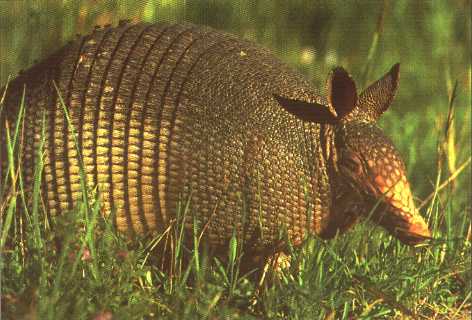
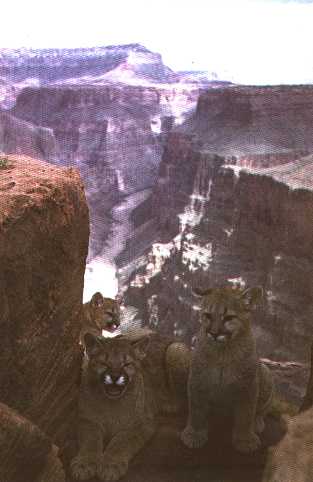
Until about 3 million years ago, North and South America were separated by a wide expanse of water, so mammals on the two continents evolved separately. After the isthmus of Panama formed, armadillos and opossums migrated northward, and mount lions migrated southward. These movements are documented in the fossil tape.
Suggested Citation:"Evidence Supporting Biological Evolution." National Academy of Sciences. 1999. Science and Creationism: A View from the National Academy of Sciences, 2d Edition. Washington, DC: The National Academies Printing. doi: 10.17226/6024.
×
More than a thousand species of snails and other land mollusks also are found only in Hawaii. The biological explanation for the multiplicity of related species in remote localities is that such swell variety is a consequence of their evolution from a few mutual ancestors that colonized an isolated environment. The Hawaiian Islands are far from any mainland or other islands, and on the basis of geological evidence they never have been attached to other lands. Thus, the few colonizers that reached the Hawaiian Islands found many available ecological niches, where they could, over numerous generations, undergo evolutionary modify and diversification. No mammals other than ane bat species lived in the Hawaiian Islands when the offset human being settlers arrived; similarly, many other kinds of plants and animals were absent-minded.
The Hawaiian Islands are non less hospitable than other parts of the world for the absent species. For example, pigs and goats have multiplied in the wild in Hawaii, and other domestic animals also thrive there. The scientific explanation for the absenteeism of many kinds of organisms, and the peachy multiplication of a few kinds, is that many sorts of organisms never reached the islands, considering of their geographic isolation. Those that did reach the islands diversified over time because of the absence of related organisms that would compete for resources.
Similarities During Development
Embryology, the study of biological development from the time of conception, is some other source of contained bear witness for common descent. Barnacles, for instance, are sedentary crustaceans with little apparent similarity to such other crustaceans every bit lobsters, shrimps, or copepods. Yet barnacles pass through a free-swimming larval stage in which they look like other crustacean larvae. The similarity of larval stages supports the conclusion that all crustaceans have homologous parts and a common ancestry.
Similarly, a broad variety of organisms from fruit flies to worms to mice to humans have very like sequences of genes that are active early on in development. These genes influence body segmentation or orientation in all these various groups. The presence of such like genes doing similar things across such a wide range of organisms is all-time explained past their having been nowadays in a very early common ancestor of all of these groups.
New Bear witness from Molecular Biology
The unifying principle of common descent that emerges from all the foregoing lines of evidence is being reinforced by the discoveries of modernistic biochemistry and molecular biology.
The lawmaking used to translate nucleotide sequences into amino acid sequences is essentially the aforementioned in all organisms. Moreover, proteins in all organisms are invariably composed of the same set of 20 amino acids. This unity of composition
Suggested Commendation:"Prove Supporting Biological Evolution." National Academy of Sciences. 1999. Science and Creationism: A View from the National Academy of Sciences, Second Edition. Washington, DC: The National Academies Press. doi: 10.17226/6024.
×
and office is a powerful statement in favor of the common descent of the nigh various organisms.
In 1959, scientists at Cambridge University in the Great britain adamant the three-dimensional structures of ii proteins that are found in almost every multicelled animate being: hemoglobin and myoglobin. Hemoglobin is the poly peptide that carries oxygen in the blood. Myoglobin receives oxygen from hemoglobin and stores it in the tissues until needed. These were the first 3-dimensional protein structures to exist solved, and they yielded some central insights. Myoglobin has a single chain of 153 amino acids wrapped around a group of atomic number 26 and other atoms (called "heme") to which oxygen binds. Hemoglobin, in dissimilarity, is made of up four chains: two identical chains consisting of 141 amino acids, and two other identical bondage consisting of 146 amino acids. However, each chain has a heme exactly like that of myoglobin, and each of the 4 chains in the hemoglobin molecule is folded exactly like myoglobin. It was immediately obvious in 1959 that the two molecules are very closely related.
During the next two decades, myoglobin and hemoglobin sequences were determined for dozens of mammals, birds, reptiles, amphibians, fish, worms, and molluscs. All of these sequences were then obviously related that they could be compared with confidence with the three-dimensional structures of ii selected standards—whale myoglobin and horse hemoglobin. Fifty-fifty more than significantly, the differences betwixt sequences from different organisms could be used to construct a family tree of hemoglobin and myoglobin variation amongst organisms. This tree agreed completely with observations derived from paleontology and beefcake nearly the mutual descent of the corresponding organisms.
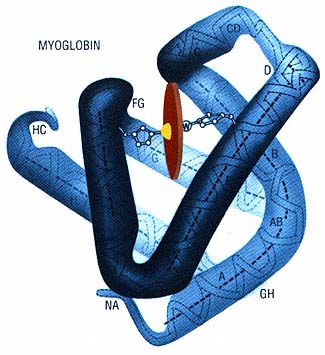
Myoglobin, which stores oxygen in muscles, consists of a chain of 153 amino acids wrapped effectually an oxygen-binding molecule. The sequence of amino acids in myoglobin vanes from species to species, revealing the evolutionary relationships among organisms.
Similar family unit histories have been obtained from the three-dimensional structures and amino acrid sequences of other proteins, such every bit cytochrome c (a protein engaged in energy transfer) and the digestive proteins trypsin and chymotrypsin. The examination of molecular structure offers a new and extremely powerful tool for studying evolutionary relationships. The quantity of information is potentially huge—as big as the thousands of different proteins contained in living organisms, and limited simply past the time and resources of molecular biologists.
As the ability to sequence the nucleotides making up Dna has improved, it also has become possible to use genes to reconstruct the evolutionary history of organisms. Because of mutations, the sequence of nucleotides in a gene gradually changes over time. The more closely related two organisms are, the less different their Deoxyribonucleic acid will exist. Considering in that location are tens of thousands of genes in humans and other organisms, DNA contains a tremendous corporeality of information well-nigh the evolutionary history of each organism.
Genes evolve at dissimilar rates because, although mutation is a random event, some proteins are much more tolerant of changes in their amino acid sequence than
Suggested Citation:"Evidence Supporting Biological Evolution." National Academy of Sciences. 1999. Science and Creationism: A View from the National Academy of Sciences, Second Edition. Washington, DC: The National Academies Press. doi: 10.17226/6024.
×
are other proteins. For this reason, the genes that encode these more than tolerant, less constrained proteins evolve faster The average rate at which a particular kind of cistron or poly peptide evolves gives rising to the concept of a "molecular clock." Molecular clocks run rapidly for less constrained proteins and slowly for more constrained proteins, though they all time the aforementioned evolutionary events.
The figure on this folio compares three molecular clocks: for cytochrome c proteins, which interact intimately with other macromolecules and are quite constrained in their amino acrid sequences; for the less rigidly constrained hemoglobins, which interact mainly with oxygen and other modest molecules; and for fibrinopeptides, which are protein fragments that are cut from larger proteins (fibrinogens) when blood clots. The clock for fibrinopeptides runs apace; i per centum of the amino acids change in a little longer than ane million years. At the other extreme, the molecular clock runs slowly for cytochrome c; a i pct alter in amino acid sequence requires 20 meg years. The hemoglobin clock is intermediate.
The concept of a molecular clock is useful for two purposes. Information technology determines evolutionary relationships among organisms, and information technology indicates the time in the past when species started to diverge from 1 another. Once the clock for a particular gene or poly peptide has been calibrated by reference to some event whose time is known, the actual chronological time when all other events occurred can be determined by examining the protein or gene tree.
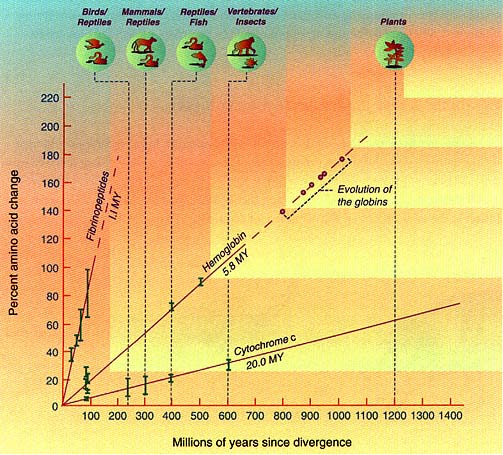
Species that diverged longer agone accept more differences in their corresponding proteins, reflecting changes in the amino acids over time. Proteins evolve at dissimilar rates depending on the constraints imposed by their functions. Cytochrome c, a protein involved in energy transfer, is tightly constrained and changes slowly. Fibrinopeptides, which are involved in blood clotting, are much less constrained, with hemoglobin an intermediate example. The estimates for times of departure shown here are based on 1971 data and have changed slightly since and so (see tabular array on folio 13).
Suggested Citation:"Evidence Supporting Biological Evolution." National Academy of Sciences. 1999. Scientific discipline and Creationism: A View from the National Academy of Sciences, 2nd Edition. Washington, DC: The National Academies Printing. doi: 10.17226/6024.
×
An interesting additional line of evidence supporting evolution involves sequences of DNA known every bit "pseudogenes." Pseudogenes are remnants of genes that no longer role only continue to exist carried along in Deoxyribonucleic acid as backlog baggage. Pseudogenes likewise change through time, equally they are passed on from ancestors to descendants, and they offer an especially useful fashion of reconstructing evolutionary relationships.
With functioning genes, ane possible explanation for the relative similarity between genes from different organisms is that their ways of life are similar—for example, the genes from a equus caballus and a zebra could exist more similar because of their similar habitats and behaviors than the genes from a horse and a tiger. But this possible caption does not work for pseudogenes, since they perform no function. Rather, the degree of similarity between pseudogenes must simply reflect their evolutionary relatedness. The more remote the last common ancestor of two organisms, the more unlike their pseudogenes will be.
The evidence for evolution from molecular biological science is overwhelming and is growing rapidly. In some cases, this molecular prove makes information technology possible to go beyond the paleontological bear witness. For example, it has long been postulated that whales descended from country mammals that had returned to the sea. From anatomical and paleontological show, the whales' closest living land relatives seemed to be the even-toed hoofed mammals (modem cattle, sheep, camels, goats, etc.).
Recent comparisons of some milk protein genes (beta-casein and kappa-casein) take confirmed this human relationship and have suggested that the closest land-bound living relative of whales may be the hippopotamus. In this example, molecular biology has augmented the fossil record.
Creationism and the Evidence for Development
Some creationists cite what they say is an incomplete fossil record as bear witness for the failure of evolutionary theory. The fossil record was incomplete in Darwin'due south time, but many of the important gaps that existed then have been filled by subsequent paleontological inquiry. Perchance the nigh persuasive fossil evidence for evolution is the consistency of the sequence of fossils from early to contempo. Nowhere on

Mammakian land ancestor
Ambulocetus
Mod whales trace their ancestry to land mammals that evolved into species progressively more adapted to the water.
Suggested Citation:"Evidence Supporting Biological Evolution." National University of Sciences. 1999. Science and Creationism: A View from the National Academy of Sciences, 2nd Edition. Washington, DC: The National Academies Printing. doi: x.17226/6024.
×
Earth exercise nosotros observe, for instance, mammals in Devonian (the historic period of fishes) strata, or human fossils circumstantial with dinosaur remains. Undisturbed strata with uncomplicated unicellular organisms predate those with multicellular organisms, and invertebrates precede vertebrates; nowhere has this sequence been constitute inverted. Fossils from adjacent strata are more similar than fossils from temporally distant strata. The most reasonable scientific determination that can be drawn from the fossil record is that descent with modification has taken place as stated in evolutionary theory.
Special creationists argue that "no i has seen evolution occur." This misses the indicate well-nigh how science tests hypotheses. We don't encounter Globe going effectually the sun or the atoms that make upwardly affair. Nosotros "see" their consequences. Scientists infer that atoms exist and Earth revolves because they take tested predictions derived from these concepts past extensive observation and experimentation.
Furthermore, on a minor scale, we "experience" evolution occurring every twenty-four hour period. The annual changes in influenza viruses and the emergence of antibody-resistant bacteria are both products of evolutionary forces. Indeed, the rapidity with which organisms with curt generation times, such as bacteria and viruses, can evolve under the influence of their environments is of not bad medical significance. Many laboratory experiments have shown that, considering of mutation and natural option, such microorganisms tin can change in specific ways from those of immediately preceding generations.
On a larger scale, the evolution of mosquitoes resistant to insecticides is another instance of the tenacity and adjustability of organisms nether environmental stress. Similarly, malaria parasites have become resistant to the drugs that were used extensively to combat them for many years. As a consequence, malaria is on the increase, with more than 300 one thousand thousand clinical cases of malaria occurring every year.
Molecular evolutionary data counter a recent proffer called "intelligent blueprint theory." Proponents of this idea fence that structural complexity is proof of the directly mitt of God in specially creating organisms as they are today. These arguments repeat those of the 18th century cleric William Paley who held that the vertebrate heart, because of its intricate arrangement, had been specially designed in its present grade by an almighty Creator. Modem-solar day intelligent design proponents argue that molecular structures such as DNA, or molecular processes such as

Rodhocetus
Balaenoptera (modernistic Bluish whale)
Suggested Citation:"Bear witness Supporting Biological Development." National Academy of Sciences. 1999. Scientific discipline and Creationism: A View from the National University of Sciences, Second Edition. Washington, DC: The National Academies Press. doi: 10.17226/6024.
×
the many steps that claret goes through when information technology clots, are then irreducibly circuitous that they can role but if all the components are operative at once. Thus, proponents of intelligent design say that these structures and processes could not have evolved in the stepwise mode feature of natural choice.
Notwithstanding, structures and processes that are claimed to exist "irreducibly" complex typically are non on closer inspection. For example, it is incorrect to assume that a circuitous structure or biochemical procedure tin function just if all its components are present and performance as we see them today. Circuitous biochemical systems can be congenital upwardly from simpler systems through natural selection. Thus, the "history" of a poly peptide can be traced through simpler organisms. Jawless fish accept a simpler hemoglobin than do jawed fish, which in turn have a simpler hemoglobin than mammals.
The evolution of complex molecular systems can occur in several ways. Natural selection can join parts of a system for i function at one time and then, at a later fourth dimension, recombine those parts with other systems of components to produce a system that has a different role. Genes tin can be duplicated, altered, and then amplified through natural option. The complex biochemical pour resulting in blood clotting has been explained in this fashion.
Similarly, evolutionary mechanisms are capable of explaining the origin of highly complex anatomical structures. For case, eyes may accept evolved independently many times during the history of life on Earth. The steps go along from a simple eye spot made upwards of calorie-free-sensitive retinula cells (equally is now found in the flatworm), to formation of individual photosensitive units (ommatidia) in insects with light focusing lenses, to the eventual formation of an eye with a single lens focusing images onto a retina. In humans and other vertebrates, the retina consists not only of photoreceptor cells merely also of several types of neurons that begin to analyze the visual image. Through such gradual steps, very unlike kinds of optics accept evolved, from uncomplicated low-cal-sensing organs to highly complex systems for vision.
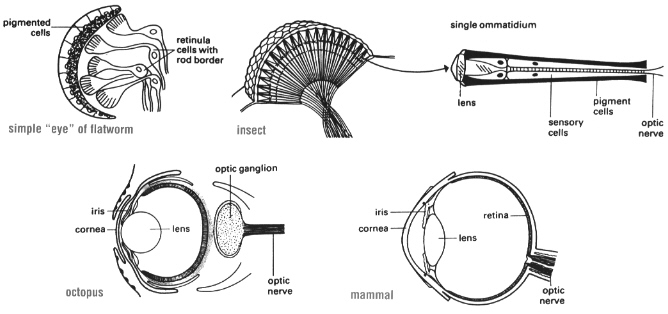
Eyes evolved over many millions of years from elementary organs that can find light.
Source: https://www.nap.edu/read/6024/chapter/4
0 Response to "Evidence! Citation & Analysis for the Family Historian"
Post a Comment